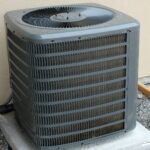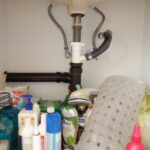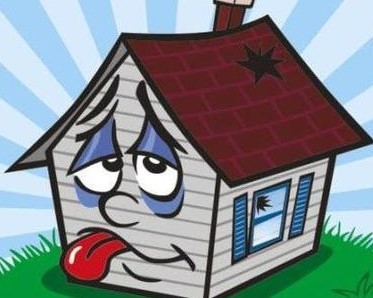One of the risks of living in our modern society is that air quality is decreasing. And, not only is it decreasing in our outdoor environment, indoor air quality (IAQ) is decreasing as well.
While a clean and healthy home is a critical component of a well rounded and happy life, the truth is that our modern society, with a multitude of discoveries resulting in thousands of products to make our environment safer and more comfortable to enjoy, is actually making us sick. And, unless the causes of the illnesses rising from indoor allergens is addressed, medical treatment for these may become more common.
The frequency of people who have asthma and other allergic diseases is rising. The Centers For Disease Control (CDC) reports that 7.0 percent of children and 8.0 percent of adults have asthma. 1)
Here is a discussion of some of the causes of poor indoor air quality; and, some possible solutions to the problem:
1 Our Heating and Cooling Systems

Modern housing comes with mechanical heating, ventilation and air conditioning (HVAC) systems. And, building codes, responding to climate change concerns are requiring our homes and ventilation systems to eliminate all possible air leaks. HVAC is probably the biggest contributor to our decreasing IAQ. Air-conditioning cools your home; and, it often leaves traces of water in the ducts. This creates the perfect breeding ground for mold and bacteria. That microbial activity is frequently the cause of respiratory issues—asthma, allergies, coughing, and headaches. The same conditions may also act as a trap for other matter floating in the air – pet dander, dead skin and more.
Solution: Have your air ducts professionally cleaned at least every couple of years. And, be sure to have your HVAC system serviced on the same service cycle. “Most of the time, most people get better after cleaning,” says Jeffrey C. May, author of the book My House Is Killing Me!. “Most people get a lot better.” 2)
2 Indoor Plumbing Leaks

Unseen leaks may be causing mold growth in your home. As a home inspector, it is amazing how many leaks we find that have been undetected for sometimes lengthy periods of time. The allergens and mold that these leaks can cause can be very problematic for people prone to asthma and allergically induced breathing problems. The leaks commonly are caused when under sink cabinets become stuffed with towels, hair solutions, cleansers and blow dryers.
Solution: Check pipes, cabinets, closets, basements, and attics to ensure that all is dry. If you find any leaky areas, clean and dry where the water has accumulated, and contact a plumber to repair the problem.
3 The Bedroom & Your Furniture

Have you had your mattress for a long time? Do you have a favorite chair? Or a favorite pillow? These are places where dust mites frequently live and thrive. And, depending upon your sensitivities may challenge your body systems to stay healthy. Dust mites are ugly, microscopic, bugs that thrive in the humidity and warmth provided by our bodies; and, they live in every home, according to the Environmental Protection Agency. 3) But for someone who is symptomatic with asthma and allergies, they can set off a reaction that is uncomfortable, and possibly extreme.
Solution: Fortunately, dust mites don’t take too kindly to hot temperatures. Put your bed sheets, pillows cases, clothes, curtains, drapes, and other washable fabrics through a wash setting between 130° and 140°F (54° to 60°C) in order to kill them. 3) Vacuum and dust weekly to rid your home of them in carpets, curtains, and furniture. Most importantly, encase your mattress and pillows in covers designed to keep dust mites from getting through. The number one doctor recommendation for how to get rid of dust mites and get protection from bed bugs is to cover your bed and pillows with protective anti-allergy bedding covers that zipper and fully encase your mattress and pillows. 4 – 6) Hypoallergenic bedding material uses tightly woven fabric that makes it nearly impossible for mites to penetrate through.
4 The Bathroom

Bath mats tend to be breeding grounds for dust mites, mold, and bacteria, especially if you step out of the shower and dry yourself on top of them. Since talcum powder has been associated with causing cancer, Cornstarch and baking soda have increasingly been used as a replacement. If you sprinkle yourself with corn starch when standing on your bath mat, you are actually feeding yeast, bacteria and dust mites.
Solution: Towel off in the tub to avoid exposing your bath mat to excess water and moisture. Launder it regularly, as if it were bedding; and, avoid corn starch.
5 Your Vacuum Cleaner

This essential household item, which we are recommending to take care of most household allergens, could actually be spewing them all back into the air. The best vacuums have a HEPA filter and filter more than 99 percent of the particulates in air. HEPA stands for “high efficiency particulate air.” Be wary of vacuums with “HEPA-type” or “HEPA-like” filters. They may look
like a traditional pleated HEPA filter and will trap some small particles, but they could miss the very microscopic ones that can make us sick.
Certain vacuum cleaners spit fine dust and bacteria back into the air, where they can spread infections and trigger allergies which is only making things worse.
Solution: Be sure your vacuum has a HEPA filter. And if you use a cleaning service, make sure they use a HEPA-filter vacuum, as well, so that your home isn’t being contaminated with allergens picked up in previously cleaned houses.
6 High Humidity

Although it is easy to think of San Diego as having a semi arid or desert influenced Mediterranean atmosphere, San Diego’s humidity drops down to 60% only once or twice a year. And, because of the rising water temperatures along the entire California coast, we are seeing ever rising humidity levels. 7)
Humidity levels are important because elevated humidity (above 60%) can cause a home to become a breeding ground for mold. This can even cause certain molds to spread behind drywall, where it lies unidentified for lengthy periods, possibly causing multiple health issues.
High humidity can attract dust mites, resulting in allergic reactions and digestive disorders.
Solution: Find ways to allow humidity to leave the house by opening windows. Be certain to run exhaust vents when showering or cooking. Consider installing a dehumidifier.
The symptoms most commonly reported by those affected by a “sick house” are many and varied, depending on the sensitivity of the person and the severity of the issues in the home. Common symptoms usually fall into a few broad categories, some of which we have discussed here.
In our experience, one of the most important indicators is the, “I just don’t feel right” feeling that doesn’t really go away. Another indicator is that you simply feel better when you leave the house.
Health complaints can range from moderate to severe, both in intensity and frequency further complicating the identification of the health impacts an unhealthy home might have on its occupants.
What can you do if you suspect that you have a sick home? Follow this six point check list carefully; and, correct any causes you find. Also, check here. There are more than just six causes and we will have a follow on article in a few weeks.
